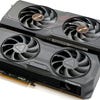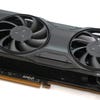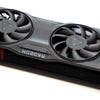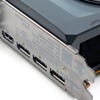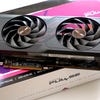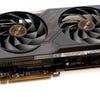AMD Radeon RX 7800 XT/7700 XT review vs RTX 4070/4060 Ti
The 7800 XT is compelling, the 7700 XT's pricing is baffling.
As we move into the mid-range sector of the GPU market, AMD's latest - and last - RDNA 3-based desktop graphics cards represent yet another golden opportunity for AMD to grab some precious market share from Nvidia. Put simply, the RTX 4060 Ti is the least compelling offering in the entire desktop 40-series line-up - it's the closest AMD is going to get to an open goal - while the RTX 4070's value proposition was controversial, being the most expensive 70-series card Nvidia has ever made.
On the face of it, AMD's new $499/£479 RX 7800 XT certainly offers a strong alternative to the RTX 4070. Based on US pricing, it's $100 cheaper, you get undeniably more potent rasterisation performance and the 12 gigs of VRAM offered by the Nvidia card gets a 4GB boost on its new AMD competitor. This is AMD making life tricky for its competition.
The $449/£429 RX 7700 XT? We're reminded of launch pricing for the RX 7900 XT - it offers proportionately less performance for the money than its more powerful counterpart with 4GB less framebuffer memory too, this time with a more impactful drop from a 16GB to 12GB allocation. It's absolutely baffling, as the RTX 4060 Ti 8GB was a turkey, and in the meantime, price cuts on the 16GB model add further pressure to the 7700 XT. It just doesn't quite make sense.
| RDNA 3 GPUs | RX 7600 | RX 7700 XT | RX 7800 XT | RX 7900 XT |
|---|---|---|---|---|
| Processor | Navi 33 | Navi 32 | Navi 32 | Navi 31 |
| Compute units | 32 | 54 | 60 | 84 |
| Game clock | 2250MHz | 2171MHz | 2124MHz | 2000MHz |
| Boost clock | 2655MHz | 2544MHz | 2430MHz | 2400MHz |
| GDDR6 memory | 8GB | 12GB | 16GB | 20GB |
| Memory interface | 128-bit | 192-bit | 256-bit | 320-bit |
| Memory speed | 18Gbps | 18Gbps | 19.5Gbps | 20Gbps |
| Infinity Cache | 32MB | 48MB | 64MB | 80MB |
| TDP | 165W | 245W | 263W | 315W |
| RRP | $269/£259 | $449/£429 | $499/£479 | $899/£899 |
As we noted in our coverage of their official announcement, both of the new AMD graphics cards are based around a singular Navi 32 GPU, with the RX 7800 XT being the fully-enabled 60CU model and the RX 7700 XT using a cut-back 54CU specification. That means the two cards should offer relatively similar performance compared to the last-gen RX 6800 XT and 6700 XT, which have 72CUs and 40CUs respectively.
Other spec points are also close between the two cards, with an 18W TDP and 1.5Gbps memory speed advantage for the 7800 XT, partially made up for a rated 114MHz boost clock advantage for the 7700 XT.
Despite sharing a common Navi 32 GPU, the two cards we tested for this review come in slightly different clothing. The RX 7800 XT is AMD's reference design, a curvy dual-slot model with two fans and two eight-pin power inputs; while the RX 7700 XT we received is a Sapphire Pulse model with a boxier appearance but matching fan count and I/O. With no special 12VHPWR connector, these can be used with a wide range of power supplies sans adapter.
Power analysis, using Nvidia's PCAT interposer hardware sitting between the graphics card and its power sources (PCIe slot and auxiliary inputs), reveals better power efficiency for the Ada Lovelace cards in terms of Joules per frame - by a relatively fine margin in non-RT titles and by a much more significant difference in RT workloads where AMD's hardware is on the back foot.
| RX 7800 XT | RTX 4070 | RX 7700 XT | RTX 4060 Ti | |
|---|---|---|---|---|
| Dying Light 2, 1440p, High RT | 249.3W/45.9fps - 5.4 Joules Per Frame | 193.5W/54.68fps - 3.6 Joules Per Frame | 229.5W/39.8fps - 5.8 Joules Per Frame | 152.2W/42.7fps - 3.6 Joules Per Frame |
| Control, 1440p, High RT | 251W/49.6fps - 5.1 Joules Per Frame | 199.1W/57.2fps - 3.5 Joules Per Frame | 230.5W/41.4fps - 5.6 Joules Per Frame | 153.1W/42fps - 3.7 Joules Per Frame |
| Forza Horizon 5, 1440p, Extreme, RT Off, 4x MSAA | 240.3W/127.7fps - 1.9 Joules Per Frame | 164.4W/119.77fps - 1.4 Joules Per Frame | 180W/104.1fps - 1.7 Joules Per Frame | 114.4W/89.1fps - 1.3 Joules Per Frame |
| Hitman 3, 1440p, Max, RT Off | 252.2W/229.2fps - 1.1 Joules Per Frame | 164.4W/119.8fps - 1.0 Joules Per Frame | 231.9W/190.3fps - 1.2 Joules Per Frame | 154.7fps/148fps - 1.1 Joules Per Frame |
For the RX 7800 XT, for example, we're looking at 5.1 and 5.4 Joules per frame respectively in Dying Light 2 and Control with RT enabled, versus just 1.9 and 1.1 Joules per frame respectively in Forza Horizon 5 and Hitman 3 with RT disabled. The RTX 4070, by contrast, requires only ~3.5Jpf in the RT workloads and 1.0-1.4Jpf in the non-RT tests. That works out as the RX 7800 XT drawing around 50 percent more Joules per frame in the RT tests, versus a narrower 25 percent increase in non-RT.
There's a similar margin for the RX 7700 XT versus the RTX 4060 Ti, with around a 55 percent increase in power consumption per frame on average in our two RT tests, versus about a 20 percent average increase in non-RT workloads. Of course, different games and scenes result in different numbers, but it's clear that Nvidia's excellent efficiency with its mid-range 40-series cards remains out of reach for AMD's RDNA 3 competitors.
With the preliminaries out of the way, it's time to get into the benchmarks proper. As usual, we're using a high-end rig that pairs a Core i9 13900K with 6000MT/s GSkill DDR5 and an Asus ROG Maximus Hero Z690 motherboard, minimising CPU bottlenecking to show GPU differences more clearly.
AMD RX 7800 XT/7700 XT Analysis
- Introduction [This Page]
- RT benchmarks: Dying Light 2, Cyberpunk 2077, Control
- RT benchmarks: Metro Exodus Enhanced Edition, F1 22
- RT/DLSS/FSR2/DLSS3 benchmarks: Cyberpunk 2077, Dying Light 2, Forza Horizon 5
- Game benchmarks: Control, Cyberpunk 2077, F1 22, Forza Horizon 5
- Game benchmarks: Hitman 3, A Plague Tale: Requiem, Returnal
- Conclusions and recommendations
.jpg?width=690&quality=75&format=jpg&auto=webp)


